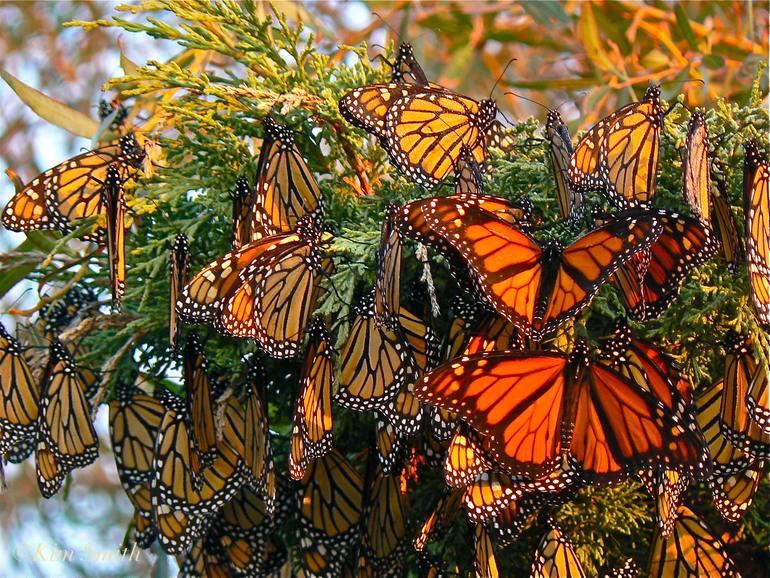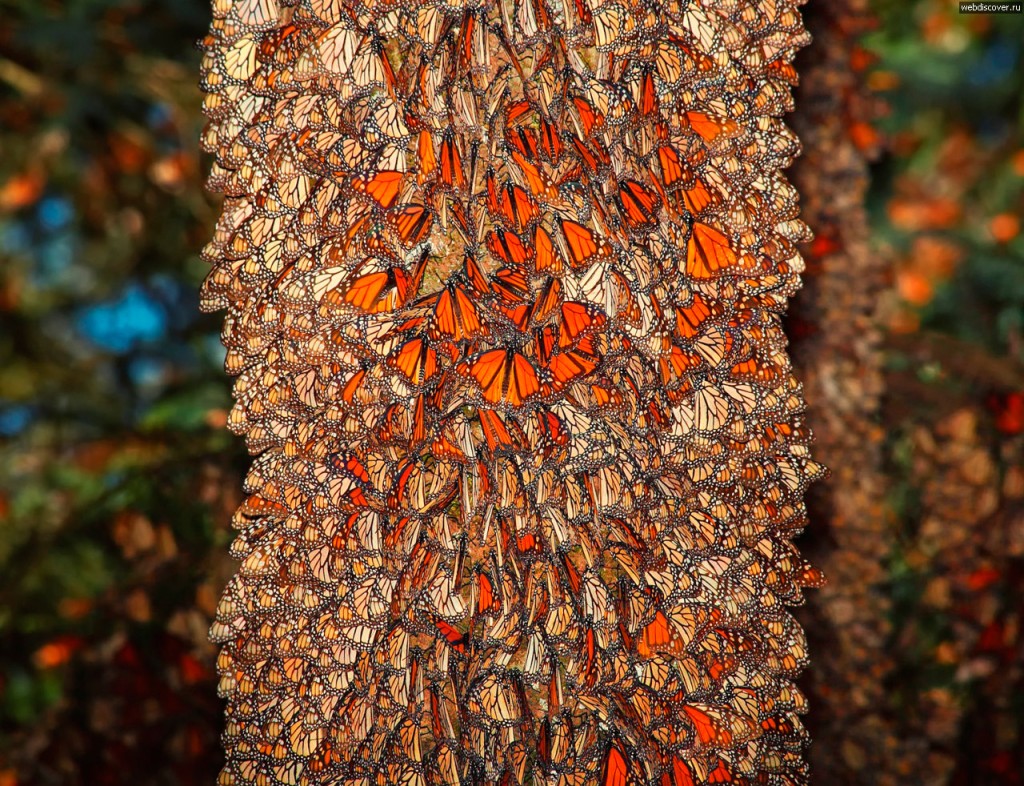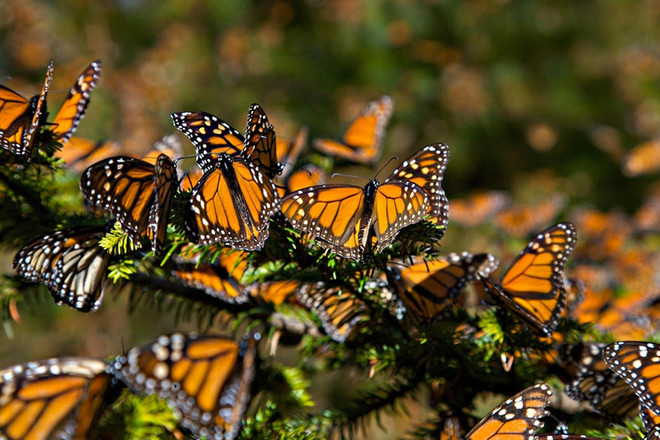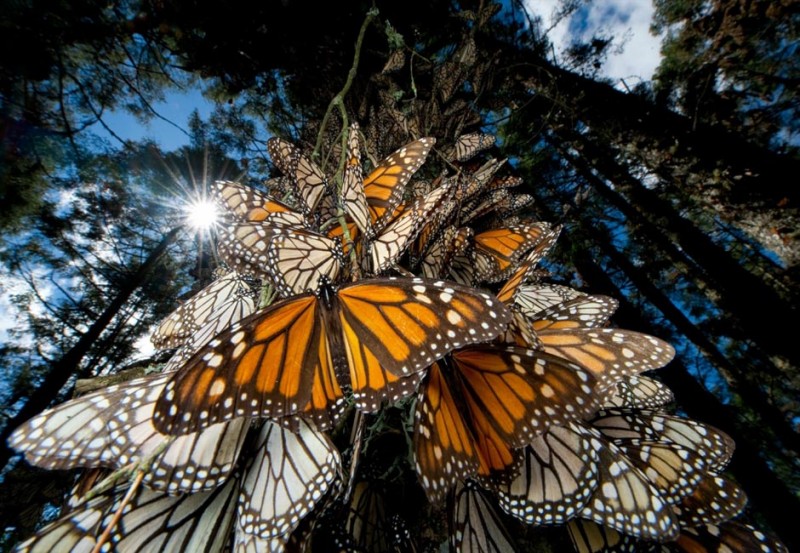May 12, 2023
The House of the Wandering Monarch
The Danaida Monarch butterfly is probably the most famous butterfly in the world. Its bright orange-black wings with a span of up to 10 cm attract attention as soon as it appears in the field of view. Can you imagine what millions of such butterflies look like gathered in one place? This picture can be observed by visitors of the Monarch Biosphere Reserve (Reserva de la biosfera de la Mariposa Monarca) on the border of the Mexican states of Michoacan and Mexico City.

This specially protected natural area with an area of more than 56,000 hectares is located in a wooded mountainous area at an altitude of approximately 3,000 m. It is the end point of the migration of monarch butterflies from North America. The climate and conditions here are ideal for wintering: it is not too hot and not too cold (about 22 °), there is enough sunlight and clean water, and the pines, firs and cedars growing here become a home for arriving royals. Every year from 60 million to a billion butterflies, like migratory birds, migrate to these regions to breed offspring.

Migration begins in August, and the fragile butterflies travel more than 6,000 km to find themselves under the warm Mexican sun. They completely cover the trees with a bright rustling blanket, forcing the branches to bend under their weight. The butterflies spend the nights huddled close to each other to keep warm, and in the morning with the first rays of the sun they open their wings to warm up as soon as possible.

The marriage dance of monarchs is amazingly beautiful, they rise into the air like a cloud, and can literally cover the sun with themselves. Each female lays about 400 eggs, until the appearance of an adult, it takes about 1 month. The whole life of monarch butterflies lasts about 7 months, so no butterfly has ever made the way back and forth. How the colonies find their way back to the north is still a mystery.
Zoologist Fred Urguhart drew the attention of the Mexican government to the colonies of monarch butterflies in 1975. Prior to that, the reserve area was considered an important area for agriculture and mining. In 1980, this area was granted the status of a nature protection zone. At first, all efforts were aimed only at creating favorable conditions for wintering monarchs, but then they spread to the entire ecosystem of the reserve. It is home to about 180 species of animals, many of which are endemic, for example, white-tailed deer or coyote.
In 2008, the reserve was awarded the UNESCO World Heritage Status.

The best time to visit the reserve is from November to March. Not the entire territory is open to tourists, but 3 zones in each of the states. The most important thing for butterflies is silence, so tourists are strictly forbidden to make noise, as well as smoke, take photos with a flash and pollute the streams from which butterflies drink.
However, to see the monarchs, it is not necessary to fly to Mexico. They live on the Canary Islands and Madeira, but, of course, there is no such cluster of winged kings and queens as in Mexico. Would you be willing to fly across the ocean to admire them?
This specially protected natural area with an area of more than 56,000 hectares is located in a wooded mountainous area at an altitude of approximately 3,000 m. It is the end point of the migration of monarch butterflies from North America. The climate and conditions here are ideal for wintering: it is not too hot and not too cold (about 22 °), there is enough sunlight and clean water, and the pines, firs and cedars growing here become a home for arriving royals. Every year from 60 million to a billion butterflies, like migratory birds, migrate to these regions to breed offspring.
Migration begins in August, and the fragile butterflies travel more than 6,000 km to find themselves under the warm Mexican sun. They completely cover the trees with a bright rustling blanket, forcing the branches to bend under their weight. The butterflies spend the nights huddled close to each other to keep warm, and in the morning with the first rays of the sun they open their wings to warm up as soon as possible.
The marriage dance of monarchs is amazingly beautiful, they rise into the air like a cloud, and can literally cover the sun with themselves. Each female lays about 400 eggs, until the appearance of an adult, it takes about 1 month. The whole life of monarch butterflies lasts about 7 months, so no butterfly has ever made the way back and forth. How the colonies find their way back to the north is still a mystery.
Zoologist Fred Urguhart drew the attention of the Mexican government to the colonies of monarch butterflies in 1975. Prior to that, the reserve area was considered an important area for agriculture and mining. In 1980, this area was granted the status of a nature protection zone. At first, all efforts were aimed only at creating favorable conditions for wintering monarchs, but then they spread to the entire ecosystem of the reserve. It is home to about 180 species of animals, many of which are endemic, for example, white-tailed deer or coyote.
In 2008, the reserve was awarded the UNESCO World Heritage Status.
The best time to visit the reserve is from November to March. Not the entire territory is open to tourists, but 3 zones in each of the states. The most important thing for butterflies is silence, so tourists are strictly forbidden to make noise, as well as smoke, take photos with a flash and pollute the streams from which butterflies drink.
However, to see the monarchs, it is not necessary to fly to Mexico. They live on the Canary Islands and Madeira, but, of course, there is no such cluster of winged kings and queens as in Mexico. Would you be willing to fly across the ocean to admire them?
Read more
July 31, 2024
April 12, 2024
April 5, 2024